Sunday 2nd August – Croft – Kay’s sister and brother-in-law are staying with us. They have brought Freddy, a six month old Westie – another name for a terror! David and I set off with the dogs up to Croft Ambrey. Maddy just wants to play with her 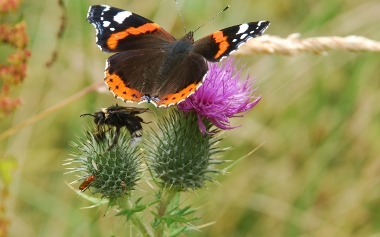 ball, Freddy just follows with his nose under her tail. It is humid and rain threatens. Flies are annoying around our heads. Sloes are still green, but are just beginning to darken. There are few flowers in the woods, just tall spikes of Foxgloves with maybe one or two flowers at the very tops, whilst below are the round, green seed pods. Towards the Iron Age fort it becomes increasingly muddy. This is not surprising considering the amount of rain that has fallen recently, but it is still the first time I have encountered this amount of mud. We cross the fort and start to descend the hill, through the woodland. The first slope down the woods is horribly slippery and we both slide in the mud. At the bottom of the slope some walkers tell us the normal track down is now a small stream so we detour around the Forestry Commission road. A pristine Red Admiral is feeding on a thistle. As I take the picture I realise there is a bee on the flower next to the butterfly. Identified later, the bee turns out to be a Vestal Cuckoo Bee Psithyrus vestalis, one that parasitises the Buff-tailed Bumblebee, Bombus terrestris. Even later, enlarging the picture, it emerges there is a Bloodsucker, a little red Soldier Beetle Rhagonycha fulva lower on the same flower head. Other bees are nearby, a Common Carder Bee, Bombus pascuorum and what may be another Cuckoo Bee, Bombus campestris. We continue down Fishpool Valley. Some of the ponds have an eerie blue-green tinge to them.
ball, Freddy just follows with his nose under her tail. It is humid and rain threatens. Flies are annoying around our heads. Sloes are still green, but are just beginning to darken. There are few flowers in the woods, just tall spikes of Foxgloves with maybe one or two flowers at the very tops, whilst below are the round, green seed pods. Towards the Iron Age fort it becomes increasingly muddy. This is not surprising considering the amount of rain that has fallen recently, but it is still the first time I have encountered this amount of mud. We cross the fort and start to descend the hill, through the woodland. The first slope down the woods is horribly slippery and we both slide in the mud. At the bottom of the slope some walkers tell us the normal track down is now a small stream so we detour around the Forestry Commission road. A pristine Red Admiral is feeding on a thistle. As I take the picture I realise there is a bee on the flower next to the butterfly. Identified later, the bee turns out to be a Vestal Cuckoo Bee Psithyrus vestalis, one that parasitises the Buff-tailed Bumblebee, Bombus terrestris. Even later, enlarging the picture, it emerges there is a Bloodsucker, a little red Soldier Beetle Rhagonycha fulva lower on the same flower head. Other bees are nearby, a Common Carder Bee, Bombus pascuorum and what may be another Cuckoo Bee, Bombus campestris. We continue down Fishpool Valley. Some of the ponds have an eerie blue-green tinge to them.
Thursday 6th August – Home – Back after a night in hospital with a heart flutter. A pulse of 160bpm would not reduce so the doctor “rebooted” me with an electric shock that solved the problem. The major downside is that I have been instructed to seriously reduce my alcohol intake, so it looks like a period “on the wagon” is needed. Voices in the garden adjoining ours brings me to the window. There is a man in protective clothing and a face net and a large swarm of wasps under the eaves of the house beyond the garden. He has a tin on a long pole and is squirting some white powder into the break in the eaves which appears to be the source of the wasps. Later there are large numbers of screaming Swifts high in the sky.
Friday 7th August – Home – The tomatoes in the greenhouse are a disaster area. They have bad blight and it looks that little can be saved. It was clearly a mistake to allow the bush type, Silvery Fir Tree, to just run wild. Peppers however are doing well and there a numerous chillies growing. The lettuce gap has not yet filled, the next crop being too small. The following sowing has annoyingly all been eaten, probably by slugs. I have another sowing germinated and they will be planted out next week. I sow some spring onions and carrots for an autumn crop. What looks like a ripe fig turns out to be a shell – the birds have feasted from behind and emptied out the skin. Runner and French beans are still prolific. The two winter sown cabbages continue to grow – they are huge, a couple of leaves are all that is needed for a meal.
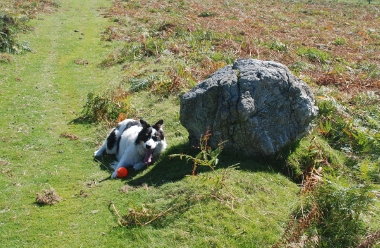
Tuesday 11th August – Hergest Ridge – It is a beautiful day! The track is a closely cropped grass avenue between Bracken and Gorse. As one gains height so the views get better and better. Large Rowan trees, probably quite old for the species, are laden with vermilion berries. Meadow Pipits flit across the gorse. Grasshoppers rasp in the grass between the bushes. Towards the summit is a ridge marking the outline of a racecourse used between 1825 to around 1880. Further on is a small plantation of Monkey Puzzle trees (Araucaria araucana) – no idea why they should be here. To the west, the flanks of Llanfihangel Hill (also known as Colva Hill) are tinged with the purple of heather. A little way to the north is the Whet Stone, a large glacial erratic which is a large stone picked up by a glacier in the Ice Age and dropped when the ice retreated. There are at least two versions of why the stone is so named. Firstly, it was a place where wheat was left for villagers during the Black Death so the traders and purchasers did not have to come into contact with each other; and secondly it was where warriors sharpened their swords before battle. The first seems to have a little more credence. We headed back down from here. Maddy continues to chase her ball then find any piece of shade going and lurk there until we catch up. A pair of Linnets chatter on the top of a gorse bush. The distant hills – the Malverns, Black Mountains, Brecon Beacons, Clee and the Shropshire Hills are all becoming hazy in the heat. On the way down we pass another, smaller erratic by the path.
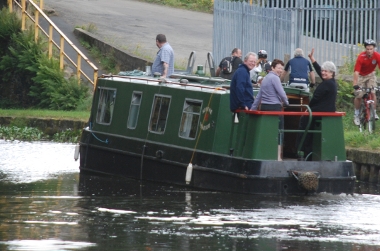
Sunday 16th August – Sowerby Bridge – We are in Yorkshire for the weekend. Brigid, Dave, Joy and Ken have bought a narrow boat between them. It is normally moored at Hebden Bridge but it has been brought to the boat yard at Sowerby Bridge for some work on the electrics. Dave and Joy have gone to Scotland but Ken and Brigid are taking themselves and a couple of friends down the Calder and Hebble Navigation. So we pay them a visit before they set off. Sowerby Bridge is a small town that I have often passed through but never stopped to look around. It was an important crossing over the Calder in mediaeval times. In 1740, the people of Halifax, Ripponden and Elland petitioned for the river to be made navigable  upstream of Wakefield. This was finally completed in 1770. Plans to build the Rochdale Canal were revived in 1790 and the link was completed in 1804 making it the first trans-Pennine waterway. Sowerby Bridge was an important dock with warehouses where loads were trans-shipped from the “Mersey Flats” that plied the Rochdale Canal over to the “Yorkshire Keels” that sailed on down the Calder and Hebble Navigation. We board the boat and take a short trip down towards Elland. We pass large walls with blocked-off windows and doors, all that remains of Canal Mills. A little further on Sterne Mills are just an area of rubble, although they are shown as “disused” on the 1908 Ordnance Survey. We disembark here and have a cup of tea – very British! Maddy and I wander over to the river which is crossed by a bridge, a large concrete structure marked “AD 1914”. There is a weir across the river here. A female Goosander flies off from the top of the weir. A Grey Wagtail struts along through the
upstream of Wakefield. This was finally completed in 1770. Plans to build the Rochdale Canal were revived in 1790 and the link was completed in 1804 making it the first trans-Pennine waterway. Sowerby Bridge was an important dock with warehouses where loads were trans-shipped from the “Mersey Flats” that plied the Rochdale Canal over to the “Yorkshire Keels” that sailed on down the Calder and Hebble Navigation. We board the boat and take a short trip down towards Elland. We pass large walls with blocked-off windows and doors, all that remains of Canal Mills. A little further on Sterne Mills are just an area of rubble, although they are shown as “disused” on the 1908 Ordnance Survey. We disembark here and have a cup of tea – very British! Maddy and I wander over to the river which is crossed by a bridge, a large concrete structure marked “AD 1914”. There is a weir across the river here. A female Goosander flies off from the top of the weir. A Grey Wagtail struts along through the  shallow water. Some old industrial equipment is on a jetty downstream with a beautifully made wheel which seemed to have driven a gearing for some purpose no longer clear. Just up from the mooring is a large patch of Arrowhead, a water-plantain with a white flower adorned with a large purple spot. Ken and Brigid set off and we walk back to Sowerby Bridge along a very busy tow-path. It is annoying to see how much Himalayan Balsam is growing all along the canal, pushing out the native plants. Back at the canal basin we head into the town. We pass St Anns Square, maybe once a prime site, now weeds grow through the cobbles of this murky backstreet. Up the hill a short way to Tuel Lane deep lock. With a fall of 19 feet 8½ inches (6.01 m), it is the deepest lock in Britain. (Ken had informed that the deepest lock in the world is Oskemen Lock, bypassing a hydro-electric dam on the River Ertis in Kazakhstan, with an fall of 138 ft – I imagine not a lot of people know that!) Heading back we pass a lock gate set by the entrance to the boat yard with bronze statues of a man and boy pushing it.
shallow water. Some old industrial equipment is on a jetty downstream with a beautifully made wheel which seemed to have driven a gearing for some purpose no longer clear. Just up from the mooring is a large patch of Arrowhead, a water-plantain with a white flower adorned with a large purple spot. Ken and Brigid set off and we walk back to Sowerby Bridge along a very busy tow-path. It is annoying to see how much Himalayan Balsam is growing all along the canal, pushing out the native plants. Back at the canal basin we head into the town. We pass St Anns Square, maybe once a prime site, now weeds grow through the cobbles of this murky backstreet. Up the hill a short way to Tuel Lane deep lock. With a fall of 19 feet 8½ inches (6.01 m), it is the deepest lock in Britain. (Ken had informed that the deepest lock in the world is Oskemen Lock, bypassing a hydro-electric dam on the River Ertis in Kazakhstan, with an fall of 138 ft – I imagine not a lot of people know that!) Heading back we pass a lock gate set by the entrance to the boat yard with bronze statues of a man and boy pushing it.
Tuesday 25th August – Crickhowell – We are meeting friends here in this delightful small Welsh town. In Welsh the town is called Crug Hywell, after an Iron Age fort high on the hills above. We have arrived early so we pay a quick visit to the site of the castle. There really is not much left to see, part of one tower and even less of another with a high motte 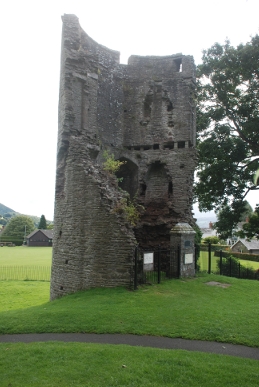 between them. The first castle here would have been wooden and probably constructed by the Norman Robert Turberville, tenant of Bernard de Neufmarche. The stone castle was built in 1272 by Sir Grimbald Pauncefote, who had married Sybil, an heiress to the Turbervilles. The castle became the property of Roger Mortimer, presumably through his marriage to Joan Turberville. In 1322, Edward took the castle as part of his dispute with Mortimer, which involved, amongst other things his affair with Edward’s wife Isabella! Mortimer took back the castle by 1330 and had installed Alisby as governor. The castle is still sometimes called Alisby’s Castle. Mortimer was executed in by Edward III and the castle was returned to the Pauncefotes. Henry IV ordered John Pauncefote (Sir Grimbald’s great grandson) to refortify the castle in 1400, but it was attacked and badly damaged by Owain Glandŵr in 1402. Later that century, Sir William Herbert, who became earl of Pembroke, was granted the land but it was recorded as inhabitable by the reign of Elizabeth I. There is a pleasant view from the motte – the Black Mountains beyond the roofs of the town. We lunch at the Bear Inn, an old coaching inn with “Post Horses” still painted over the arch to the stables. Opposite is Webbs of Crickhowell, a wonderful old fashioned department store that sells everything the home needs.
between them. The first castle here would have been wooden and probably constructed by the Norman Robert Turberville, tenant of Bernard de Neufmarche. The stone castle was built in 1272 by Sir Grimbald Pauncefote, who had married Sybil, an heiress to the Turbervilles. The castle became the property of Roger Mortimer, presumably through his marriage to Joan Turberville. In 1322, Edward took the castle as part of his dispute with Mortimer, which involved, amongst other things his affair with Edward’s wife Isabella! Mortimer took back the castle by 1330 and had installed Alisby as governor. The castle is still sometimes called Alisby’s Castle. Mortimer was executed in by Edward III and the castle was returned to the Pauncefotes. Henry IV ordered John Pauncefote (Sir Grimbald’s great grandson) to refortify the castle in 1400, but it was attacked and badly damaged by Owain Glandŵr in 1402. Later that century, Sir William Herbert, who became earl of Pembroke, was granted the land but it was recorded as inhabitable by the reign of Elizabeth I. There is a pleasant view from the motte – the Black Mountains beyond the roofs of the town. We lunch at the Bear Inn, an old coaching inn with “Post Horses” still painted over the arch to the stables. Opposite is Webbs of Crickhowell, a wonderful old fashioned department store that sells everything the home needs.
Govilon-Llanfoist – We head south-east from Crickhowell to Govilon, just beyond the “Head of the Valleys Road”. Govilon is on the northern edge of the Blaenaven World Heritage Site. We climb the streets through the village and come to the old railway. A tramway was constructed here in 1820 by Crayshaw Bailey to move coal and iron. In 1859 J & C Bailey conveyed Baileys tramroad to the newly formed Merthyr, Tredegar and Abergavenny Railroad. This company was formed to build a line from Abergavenny to Merthyr. 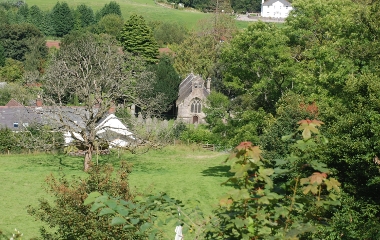 In November 1861, the line was taken over by the London and North Western Railway, later part of the London, Midland and Scotland Railway – the L.M.S., one of the “great four”. The line closed in January 1958. The line and the nearby Monmouthshire and Brecon Canal run around the lower slopes of 561 metre high hill called Blorenge, the only major hill of the Black Mountains to lie on this side of the Head of the Valleys Road. The mass of the Black Mountains lies across the Usk Valley below. The track passes the Old Station, now a private residence. Trees rise either side of the track, obscuring the view but providing a pleasant shade. Old Man’s Beard climbs some trunks and out onto lower branches. Pigs root around in a field. People have already picked many blackberries. The track enters Llanfoist (Llanffwyst) and a steep path leads up past the church to the canal at Boat Houses. Here is
In November 1861, the line was taken over by the London and North Western Railway, later part of the London, Midland and Scotland Railway – the L.M.S., one of the “great four”. The line closed in January 1958. The line and the nearby Monmouthshire and Brecon Canal run around the lower slopes of 561 metre high hill called Blorenge, the only major hill of the Black Mountains to lie on this side of the Head of the Valleys Road. The mass of the Black Mountains lies across the Usk Valley below. The track passes the Old Station, now a private residence. Trees rise either side of the track, obscuring the view but providing a pleasant shade. Old Man’s Beard climbs some trunks and out onto lower branches. Pigs root around in a field. People have already picked many blackberries. The track enters Llanfoist (Llanffwyst) and a steep path leads up past the church to the canal at Boat Houses. Here is 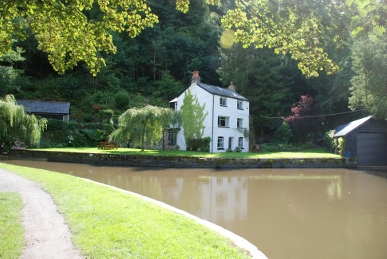 a canal basin with a fine three storied house, painted bright white and a long warehouse converted into flats. An old crane stands by the edge of the water. An old Collie looks across the canal at Maddy, who is too busy with her ball to notice. The canal winds back around the side of the hill. It is clear that a lot of effort is put into maintaining it. There is a steep wooded slope above and below it. A long box of planks stands by the tow-path, their use yet to be determined. (I eventually work out these are to block off sections of canal so it can be drained for repairs.) We decide that Maddy can do without her ball which would inevitably end up in the water, not that she agrees! On the opposite bank is a gate which clearly would close off the canal, but not as a lock. It has 1070Kg carved into its end post and an iron plaque dated 1996. The tow-path crosses an ancient cobbled bridge and then continues into another boat yard, albeit a larger one and populated with numerous cruisers and narrow boats. We climb up to a road and head back down the hill again to Govilon.
a canal basin with a fine three storied house, painted bright white and a long warehouse converted into flats. An old crane stands by the edge of the water. An old Collie looks across the canal at Maddy, who is too busy with her ball to notice. The canal winds back around the side of the hill. It is clear that a lot of effort is put into maintaining it. There is a steep wooded slope above and below it. A long box of planks stands by the tow-path, their use yet to be determined. (I eventually work out these are to block off sections of canal so it can be drained for repairs.) We decide that Maddy can do without her ball which would inevitably end up in the water, not that she agrees! On the opposite bank is a gate which clearly would close off the canal, but not as a lock. It has 1070Kg carved into its end post and an iron plaque dated 1996. The tow-path crosses an ancient cobbled bridge and then continues into another boat yard, albeit a larger one and populated with numerous cruisers and narrow boats. We climb up to a road and head back down the hill again to Govilon.